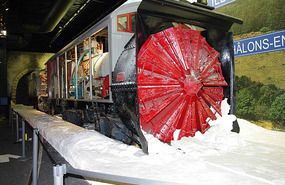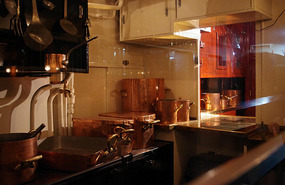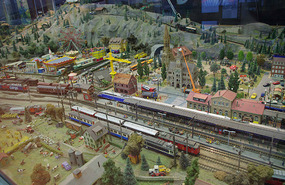No, this entry isn't about the movie…and it actually isn’t about planes or automobiles either. Today was all about the trains. We visited the "Cité du Train" in Mulhouse, a veritable paradise for any train lover. There is also a “Cité de l’Automobile” but we didn’t have time for it this time around and Meghan and I prefer trains over automobiles. We aren’t obsessed with trains but do enjoy riding them and think that it is a convenient, more eco-friendly mode of transport that is often overlooked.
It was a weekday so it wasn’t very crowded and we essentially had the whole museum to ourselves. With our audio guide in hand, we began our tour with some of the first trains in France, the Michelins, which actually had rubber wheels like an automobile. The displays were very well done and we learned about various types of train used throughout the history of France’s rail system, leading up to the present day, high-speed TGVs.
All the trains in the museum were once in active service and have been relocated and refurbished. We saw a variety of trains including those used to plow snow and clear tracks, carry supplies, transport army goods and even one that was used as a mobile hospital to carry injured soldiers from the front. One of the trains that was particularly interesting was a double-decker train where access to the top level was gained by climbing a ladder on the outside of the train – we didn’t think that was very practical in the winter or if you had a lot of luggage and I guess that’s probably why we don’t see too many of those around anymore. The majority of the trains were passenger trains and on some of them, we were allowed to walk inside or stick our heads in to see how they would have been furnished. Once we were done wandering around in the first hangar, we moved on to see trains from the early 1900s to modern day trains, organized chronologically .
They had an amazing, display with moving lights that visually explained how steam was used to power trains. We were then able to walk underneath the engine car of another train, similar to how a mechanic would under a car. From then on, we wandered past tens of carriages and engines, each with an associated audio explanation. We would have been there the whole day and we had to carry on driving towards Royan so we only stopped at the ones that looked particularly interesting. One of my favourites was the kitchen car of a royal train with all its copper pots and utensils on display.
About three hours later, we were near the exit and came across the most impressive model train set I have ever seen. It must have been about seven or eight meters long by about two meters. We unfortunately didn’t have a coin on hand to operate it and there was no one around to get one from so we just had to imagine what it would have been like – hopefully the pictures do it some justice.
The final exhibit gave a glimpse of the future of trains, showing some high-speed TGVs which have broken 800 km/h! It was interesting to note that the French government had decided, sometime after WWII, to invest more heavily in building out the rail network and associated technology than in automobiles.
Before leaving the museum entirely, we decided to stop in at the on-site restaurant, named the “Mistral” after one of the iconic French trains. We had a tasty lunch before setting out on our drive towards Beaune, our next stop en-route to Royan.
Planes, Trains and Automobiles
Wednesday, November 14, 2012
 Mulhouse, Alsace, France
Mulhouse, Alsace, France
Other Entries
-
51Munich
Oct 1233 days prior Munich, Germanyphoto_camera157videocam 0comment 5
Munich, Germanyphoto_camera157videocam 0comment 5 -
52Herrenchiemsee palace
Oct 1332 days prior Herrnchiemsee, Germanyphoto_camera9videocam 0comment 1
Herrnchiemsee, Germanyphoto_camera9videocam 0comment 1 -
53Innsbruck
Oct 1431 days prior Innsbruck, Austriaphoto_camera85videocam 0comment 7
Innsbruck, Austriaphoto_camera85videocam 0comment 7 -
54Return to Forni di Sopra
Oct 2124 days prior Forni di Sopra, Italyphoto_camera24videocam 0comment 5
Forni di Sopra, Italyphoto_camera24videocam 0comment 5 -
55Berchtesgaden
Oct 2322 days prior Berchtesgaden, Germanyphoto_camera18videocam 0comment 1
Berchtesgaden, Germanyphoto_camera18videocam 0comment 1 -
56Salzburg
Oct 2421 days prior Salzburg, Austriaphoto_camera48videocam 0comment 0
Salzburg, Austriaphoto_camera48videocam 0comment 0 -
57Hallstatt
Oct 2520 days prior Hallstatt, Austriaphoto_camera37videocam 0comment 3
Hallstatt, Austriaphoto_camera37videocam 0comment 3 -
58Mauthausen Concentration Camp
Oct 2619 days prior Mauthausen, Austriaphoto_camera22videocam 0comment 1
Mauthausen, Austriaphoto_camera22videocam 0comment 1 -
59Melk Abbey
Oct 2718 days prior Melk, Austriaphoto_camera66videocam 0comment 1
Melk, Austriaphoto_camera66videocam 0comment 1 -
60Vienna
Oct 3114 days prior Vienna, Austriaphoto_camera133videocam 0comment 1
Vienna, Austriaphoto_camera133videocam 0comment 1 -
61Telc & Trebon
Nov 0212 days prior Telc, Czech Republicphoto_camera23videocam 0comment 1
Telc, Czech Republicphoto_camera23videocam 0comment 1 -
62Cesky Krumlov
Nov 0311 days prior Cesky Krumlov, Czech Republicphoto_camera25videocam 0comment 1
Cesky Krumlov, Czech Republicphoto_camera25videocam 0comment 1 -
63Prague
Nov 068 days prior Prague, Czech Republicphoto_camera83videocam 2comment 4
Prague, Czech Republicphoto_camera83videocam 2comment 4 -
64Kutna Hora and Terezin Ghetto
Nov 077 days prior Terezin, Czech Republicphoto_camera33videocam 0comment 3
Terezin, Czech Republicphoto_camera33videocam 0comment 3 -
65Christmas Town of Seiffen
Nov 095 days prior Seiffen, Germanyphoto_camera49videocam 0comment 5
Seiffen, Germanyphoto_camera49videocam 0comment 5 -
66Nazi Party Rally Grounds in Nuremberg
Nov 113 days prior Nuremberg, Germanyphoto_camera21videocam 0comment 1
Nuremberg, Germanyphoto_camera21videocam 0comment 1 -
67Rothenburg
Nov 122 days prior Rothenburg ob der Tauber, Germanyphoto_camera50videocam 0comment 1
Rothenburg ob der Tauber, Germanyphoto_camera50videocam 0comment 1 -
68Planes, Trains and Automobiles
Nov 14 Mulhouse, Francephoto_camera34videocam 0comment 6
Mulhouse, Francephoto_camera34videocam 0comment 6 -
69Beaune
Nov 151 day later Beaune, Francephoto_camera60videocam 0comment 7
Beaune, Francephoto_camera60videocam 0comment 7 -
70Royan
Nov 195 days later Royan, Francephoto_camera9videocam 0comment 4
Royan, Francephoto_camera9videocam 0comment 4 -
71A second visit to London
Nov 2511 days later London, United Kingdomphoto_camera93videocam 0comment 15
London, United Kingdomphoto_camera93videocam 0comment 15 -
72En route to Bangalore
Nov 2612 days later Dubai, United Arab Emiratesphoto_camera10videocam 0comment 3
Dubai, United Arab Emiratesphoto_camera10videocam 0comment 3 -
73Bangalore
Dec 1632 days later Bangalore, Indiaphoto_camera134videocam 0comment 17
Bangalore, Indiaphoto_camera134videocam 0comment 17 -
74London, our third and final visit?
Dec 1935 days later London, United Kingdomphoto_camera32videocam 1comment 2
London, United Kingdomphoto_camera32videocam 1comment 2 -
75Visiting friends in Scotland
Jan 0451 days later Beith, United Kingdomphoto_camera68videocam 0comment 4
Beith, United Kingdomphoto_camera68videocam 0comment 4 -
76Preparing for new adventures
Jan 0855 days later Royan, Francephoto_camera3videocam 0comment 0
Royan, Francephoto_camera3videocam 0comment 0 -
77Citadel in Blaye & Dune de Pilat
Jan 1057 days later Blaye, Francephoto_camera13videocam 0comment 0
Blaye, Francephoto_camera13videocam 0comment 0 -
78Minh-Yen arrives!
Jan 1158 days later Zarautz, Spain and Canary Islandsphoto_camera7videocam 0comment 0
Zarautz, Spain and Canary Islandsphoto_camera7videocam 0comment 0 -
79Tapas in San Sebastian
Jan 1259 days later San Sebastián - Donostia, Spain and Canary Islandsphoto_camera37videocam 0comment 6
San Sebastián - Donostia, Spain and Canary Islandsphoto_camera37videocam 0comment 6 -
80Biarritz
Jan 1461 days later Biarritz, Francephoto_camera27videocam 0comment 2
Biarritz, Francephoto_camera27videocam 0comment 2 -
81St. Jean de Luz
Jan 1562 days later Saint-Jean-de-Luz, Francephoto_camera19videocam 0comment 4
Saint-Jean-de-Luz, Francephoto_camera19videocam 0comment 4 -
82An unforgettable lunch in Bilbao
Jan 1663 days later Bilbao, Spain and Canary Islandsphoto_camera28videocam 0comment 1
Bilbao, Spain and Canary Islandsphoto_camera28videocam 0comment 1 -
83Sipping Port in Porto
Jan 1966 days later Porto, Portugalphoto_camera64videocam 0comment 2
Porto, Portugalphoto_camera64videocam 0comment 2 -
84Batalha Monastery
Jan 2067 days later Batalha, Portugalphoto_camera18videocam 0comment 0
Batalha, Portugalphoto_camera18videocam 0comment 0 -
85Nazaré, Alcobaça & Óbidos
Jan 2168 days later Alcobaca, Portugalphoto_camera57videocam 1comment 0
Alcobaca, Portugalphoto_camera57videocam 1comment 0 -
86Lisbon
Jan 2370 days later Lisbon, Portugalphoto_camera99videocam 0comment 0
Lisbon, Portugalphoto_camera99videocam 0comment 0
Comments
2025-05-22
Comment code: Ask author if the code is blank

 Mulhouse, Alsace, France
Mulhouse, Alsace, France











































Mike J
2013-01-11
Anoop - I really did not train you right - you went right through Stuttgart and did not see the Porsche museum or factory --- ?? Geeze ....
:-) At least you looked at some trains. Cool pictures!
Cheers,
Mike
Mom
2013-02-04
Wish I could have been with you. I love trains. Great pics.